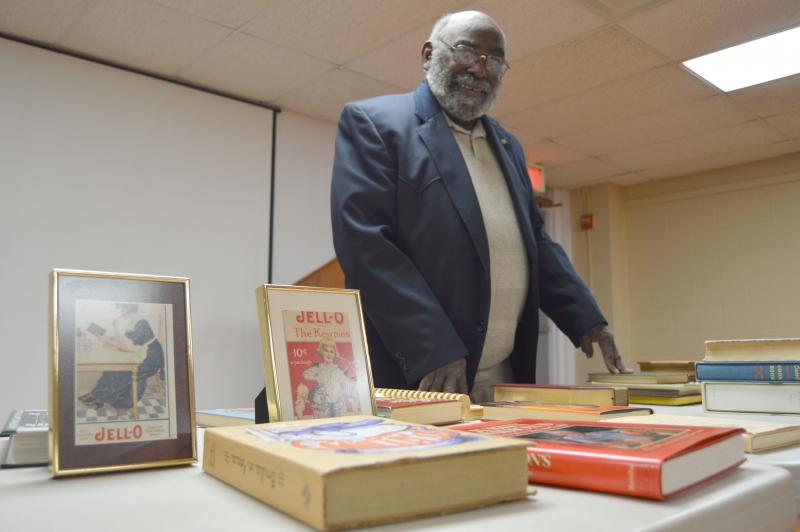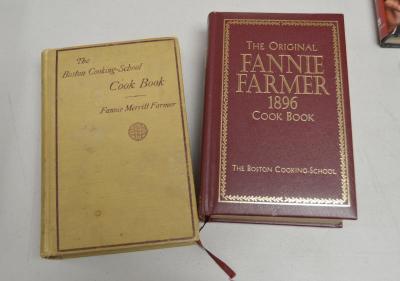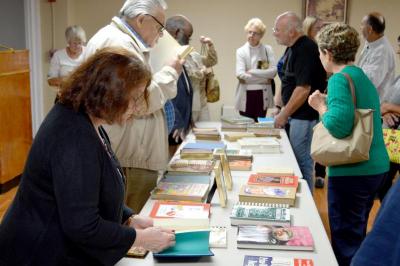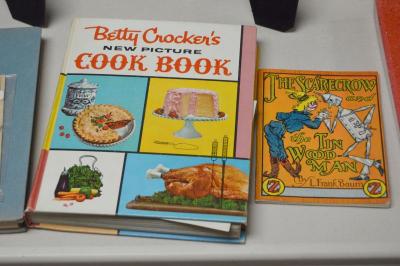Chuck Williams tells American history through gastronomy
Long before foodie blogs made new recipes only a click away, cookbooks were the authority for at-home chefs. But, as cookbook aficionado Chuck Williams noted, the history of American cookbooks is nearly as old as the country.
Williams said he’s loved reading cookbooks since age 10 – a passion that continues 71 years later. After retiring from the medical field, he started selling books wholesale. He’s since transitioned to selling directly to customers at his shop, Eagle Trading Company, a bookstore in Assonet that exclusively sells cookbooks.
On Thursday night, Williams brought some rarities from his collection to Southworth Library to give patrons a history lesson in American cookbooks.
He said the history of American cookbooks begins much like the history of America – with colonists rejecting English influence. When people began settling in the colonies, they brought English cookbooks with them.
“That’s fine, except for one thing: the indigenous products we had here would not fit the recipes. So we started out on our own adventure in creating cookbooks for this country,” he said.
The first was Amelia Simmon’s “American Cookery,” first printed in 1796.
“When you read her publication, you can tell she wasn’t formally trained, and she spelled just like the rest of us,” he said. “Her book circulated so rapidly that, before the 1800s, some of the recipes in her book were appearing in English cookbooks.”
In the years that followed, more books tailored to an American sensibility were published. In 1869, Harriet Beecher Stowe, remembered most for “Uncle Tom’s Cabin,” co-authored a cookbook with her sister titled, “The American Woman’s Home: Or, Principles of Domestic Science.”
“There’s not anything in there about Uncle Tom, but there’s a whole lot about cooking,” said Williams.
He said it was common for recipes of that era to be presented in prose rather than in a list of steps. Cookbooks also featured more than recipes. They provided information on everything from how to butcher a hog to candle making to the proper treatment of servants.
Authors didn’t use a system of measurements that was consistent, either. Because authors would call for a “pinch” or a “ball” of an ingredient, recipes were vague and hard to reproduce.
During the presentation, he read an example from a book from the era that instructed the reader, when starting a recipe, to “put a little lard on the frying pan and make it hot.”
This changed in 1896 when the first edition of Fannie Farmer’s famed “Boston Cooking-School Cook Book” was published.
He said her book was revolutionary at the time because of its inclusion of specific measurements, such as heating food at specific temperatures and the inclusion of cups and tablespoons.
“She said the way to do it was not to say ‘ball of butter.’ [Instead], put butter on a spoon, run a knife over the top and you have one tablespoon of butter. If everyone did that, the recipe would turn out good. Level measurements reconstructed the idea of cooking,” said Williams.
He said Farmer initially had issues publishing her book because it didn’t offer anything outside of recipes. Farmer was undeterred and sold advertisements in the back of her book to pay for its publication. The original run of the book was only 3,500 copies, but the book became a hit.
“There was one time Fannie Farmer’s cookbook outsold the Bible. When the older patents ran out, they decided to reissue the book and they [designed] it like a Bible,” he said.
Williams presented a reprint of the original cookbook, complete with gilded edges and a ribbon marker.
In the 20th century, cookbooks became regionalized as small church and charitable groups began to self-publish spiral bound recipe collections.
Williams recommends to anyone interested in authoring their own book to create a theme for the cookbook and to not deviate from that theme. He said it’s important to include a date of publication, the town and state where it was published, and the book should have an International Standard Book Number (ISBN).
In the end, he said that cookbooks are just another form of information.
“Cooking is simple once you grasp the idea,” Williams said. “You don’t have to remember a recipe. What you begin to do is associate the stuff in that recipe with what you already know. You’re seldom going to use a whole recipe once you know how to cook. You’ll find some circumstances precipitate good ideas.”
















